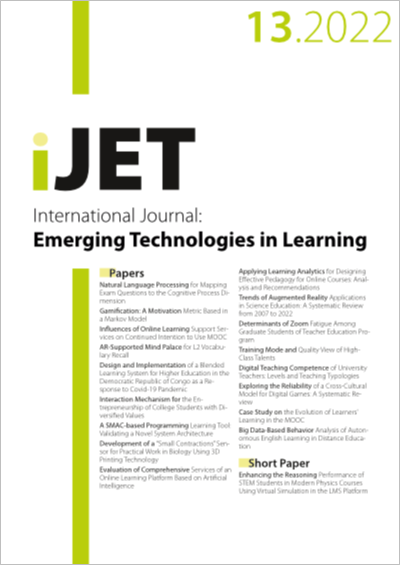Digital Teaching Competence of University Teachers: Levels and Teaching Typologies
DOI:
https://doi.org/10.3991/ijet.v17i13.24345Keywords:
digital competence, higher education, self-assessment, teacher training, didactic competence, professional developmentAbstract
Today, university teachers need to have not only basic digital skills, but to be able to use technologies in teaching-learning processes, in their professional development and that of their students. This article focuses on analysing digital teaching competence (DTC), and exploring its dimensions based on the self-perception of a sample of 558 teachers from a Spanish university, following the European DigCompEdu framework. According to the results, university teachers perceive themselves to have an intermediate level of DTC. Technical and professional aspects were higher than the pedagogical ones and those that refer to the effect on student’s digital competence. The ANOVA test did not show significant differences in DTC according to the academic position, but it did according to the scientific area. One of the most significant findings is that the DTC would not be a unitary construct; after the factorial analysis of the items, three categories were obtained that can constitute different teaching typologies: the inspiring teacher, the creator and the tutor. This study provides a new instrument to explore university teachers’ level of DTC and contributes to the debate on this competence by exploring the categories that underlie it, providing data that can be useful both at a scientific level and in the development of practices and policies for teaching improvement.
Downloads
Published
2022-07-11
How to Cite
Esteve-Mon, F. M., Llopis-Nebot, M. Ángeles, Viñoles-Cosentino, V., & Adell-Segura, J. (2022). Digital Teaching Competence of University Teachers: Levels and Teaching Typologies. International Journal of Emerging Technologies in Learning (iJET), 17(13), pp. 200–216. https://doi.org/10.3991/ijet.v17i13.24345
Issue
Section
Papers
License
Copyright (c) 2022 Francesc M. Esteve-Mon, Mª. Ángeles Llopis-Nebot, Virginia Viñoles-Cosentino, Jordi Adell-Segura

This work is licensed under a Creative Commons Attribution 4.0 International License.



